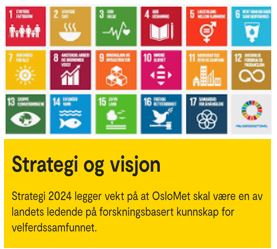Sustainability in professional education
Gap between strategy and program plans?
DOI:
https://doi.org/10.7577/formakademisk.3955Keywords:
STAUNCH, Goodlad, sustainability, strategy, program plansAbstract
Education is a key to long lasting changes in society. In the present study, theory from sustainability and education is used to examine the education of product designers, teachers and engineers at the Faculty of Technology, Art and Design (TKD) in light of OsloMet's overall strategy on welfare and sustainability. The empirical data is based on learning outcome descriptions from the program plans for 2019 and 2020 for these professional educations and is analysed on the basis of the Goodlad and STAUNCH categories. All the analysed professional educations have integrated sustainability in their program plans. Sustainability is most clearly articulated in the program plan for Product Design. However, this does not mean that sustainability is unarticulated for teacher- and engineering educations. These educations are governed by National Curriculum Regulations where sustainability is described at a national level. However, the environmental perspective is more clearly articulated in the programme plans at the institutional level than the economic- and social perspective on sustainability.
References
Cooper, T. (2005). Slower Consumption – Reflections on Product Life Spans and the “Throwaway Society”. Journal of Industrial Ecology, 9(1-2), 51-67. https://doi.org/10.1162/1088198054084671 https://doi.org/10.1162/1088198054084671
Goodlad, J. I., Klein, M. F. & Tye. K.A. (1979). The Domains of Curriculum and Their Study. In T. H. Quinn & M. Hennelly (Eds.), Curriculum Inquiry: The Study of Curriculum Practice (pp. 43-76). McGraw-Hill Book Company.
Haugen, S. (Red.). (2019). Verkstedhåndbok for øvingsverkstedene på Institutt for produktdesign ved OsloMet - storbyuniversitetet: HMS, maskiner og materialer, verkstedpraksis (Revidert utgave). http://hdl.handle.net/20.500.12199/2245
Høgskolen i Oslo og Akershus. (2017). Strategi 2024. https://www.oslomet.no/om/strategi-og-visjon
Kamp, L. (2006). Engineering education in sustainable development at Delft University of Technology. Journal of Cleaner Production, 14(9), 928-931. https://doi.org/10.1016/j.jclepro.2005.11.036 https://doi.org/10.1016/j.jclepro.2005.11.036
Kirke-, utdannings- og forskningsdepartementet. (1994). Læreplan for grunnskole, videregående opplæring og voksenopplæring. Generell del. http://www.pvv.org/~torfer/jam-rapport-og-evaluering/annet/L97-laereplan-generell-del-bokmaal.pdf
Kunnskapsdepartementet. (2006). Læreplanverket for Kunnskapsløftet. https://www.nb.no/items/a9713c6622111b63c53947c7f01ee6f0?page=0&searchText=kunnskapsl%C3%B8ftet%202006
Kunnskapsdepartementet. (2013). Forskrift om rammeplan for treårige faglærerutdanninger i praktiske og estetiske fag. https://lovdata.no/dokument/SF/forskrift/2013-03-18-290?q=fagl%C3%A6rerutdanning¬%-20design,%20kunst%20og%20h%C3%A5ndverk.
Kunnskapsdepartementet. (2018). Forskrift om rammeplan for ingeniørutdanningen. https://www.regjeringen.no/contentassets/389bf8229a3244f0bc1c7835f842ab60/ny-forskrift-om-rammeplan-for-ingeniorutdanning-fastsatt-18.05.18.pdf
Lozano, R., & Young, W. (2013). Assessing sustainability in university curricula: exploring the influence of student numbers and course credits. Journal of cleaner production, 49, 134-141. https://doi.org/10.1016/j.jclepro.2012.07.032 https://doi.org/10.1016/j.jclepro.2012.07.032
Lozano, R. (2010). Diffusion of sustainable development in universities’ curricula: an empirical example from Cardiff University. Journal of Cleaner Production, 18(7), 637–644. https://doi.org/10.1016/j.jclepro.2009.07.005 https://doi.org/10.1016/j.jclepro.2009.07.005
Meld. St.28 (2015-2016). Fag - fordypning - Forståelse. En fornyelse av Kunnskapsløftet. Kunnskapsdepartementet.https://www.regjeringen.no/contentassets/e8e1f41732ca4a64b003fca213ae663b/no¬/pdfs/stm¬201520160028000dddpdfs.pdf.
Nielsen, L. M. (2019). Fagdidaktikk for Kunst og håndverk. I går, i dag, i morgen. Universitetsforlaget.
Opplæringsloven. (1998). Lov om grunnskolen og den vidaregåande opplæringa https://lovdata.no/dokument/NL/lov/1998-07-17-61
OsloMet. (2019a). OsloMet – Storbyuniversitetet. Langtidsplan og budsjett 2019-2021. https://ansatt.oslomet.no/documents/585743/54495365/Langtidsplan+og+-budsjett+2020-2020/a1091822-fbe2-88fb-3989-35e1b0434ea2
OsloMet. (2019b). Programplan for Bioteknologi- og kjemiingeniør. https://www.oslomet.no/studier/tkd/bioteknologi-kjemiingenior
OsloMet. (2019c). Programplan for Elektronikkingeniør. https://www.oslomet.no/studier/tkd/elektronikkingenior
OsloMet. (2019d). Programplan for Faglærer i design, kunst og håndverk. https://www.oslomet.no/studier/tkd/design-kunst-handverk
OsloMet. (2019e). Programplan for kompletterende ingeniør og teknologiutdanning. https://www.oslomet.no/-studier/¬tkd/¬kompletterende¬-ingenior-teknologi
OsloMet. (2019f). Programplan for Maskiningeniør. https://www.oslomet.no/studier/tkd/maskiningenior
OsloMet. (2020a). Bærekraftig utvikling for det 21. århundre. OsloMet handlingsplan for bærekraft 2021-2024. https://uni.oslomet.no/dengodestudentopplevelsen/wp-content/uploads/sites/12/2020/06/Handlingsplan-b%C3%A6rekraft_2020_web.pdf
OsloMet. (2020b). Programplan for Energi og miljø i bygg. https://www.oslomet.no/studier/tkd/energi-miljo
OsloMet. (2020c). Programplan for Produktdesign. https://www.oslomet.no/studier/tkd/produktdesign
Papanek, V. (1971). Design for the Real World: Human Ecology and Social Change. Pantheon Books.
Sibbet, D. (2008). Team leader guide: strategies and practices for achieving high performance. The Grove Consultants International.
Thompson, R. (2007). Manufacturing processes for design professionals. Thames & Hudson.
Thürer, M., Tomašević, I., Stevenson, M., Qu, T. & Huisingh, D. (2018). A systematic review of the, literature on integrating sustainability into engineering curricula. Journal of Cleaner Production. 181, 608-617. https://doi.org/10.1016/j.jclepro.2017.12.130 https://doi.org/10.1016/j.jclepro.2017.12.130
UNESCO. (2014). Shaping the Future we Want. UN Decade of Education for Sustainable Development (2005-2014) FINAL REPORT. http://unesdoc.unesco.org/images/0023/002303/230302e.pdf
World Commission on Environment and Development. (1987). Our Common Future. Oxford university press.

Downloads
Published
How to Cite
Issue
Section
License
Copyright (c) 2021 Arild Berg, Alfredo Carello, Marius Lysebo, Liv Merete Nielsen

This work is licensed under a Creative Commons Attribution-NoDerivatives 4.0 International License.
Authors who publish with this journal agree to the following terms:
- Authors retain copyright and grant the journal right of first publication with the work simultaneously licensed under a Creative Commons Attribution 4.0 License that allows others to share the work with an acknowledgement of the work's authorship and initial publication in this journal.
- Authors are able to enter into separate, additional contractual arrangements for the non-exclusive distribution of the journal's published version of the work (e.g., post it to an institutional repository or publish it in a book), with an acknowledgement of its initial publication in this journal.
- Authors are permitted and encouraged to post their work online (e.g., in institutional repositories or on their website) prior to and during the submission process, as it can lead to productive exchanges, as well as earlier and greater citation of published work (See The Effect of Open Access).
- The author(s) must manage their economic reproduction rights to any third party.
- The journal makes no financial or other compensation for submissions, unless a separate agreement regarding this matter has been made with the author(s).
- The journal is obliged to archive the manuscript (including metadata) in its originally published digital form for at least a suitable amount of time in which the manuscript can be accessed via a long-term archive for digital material, such as in the Norwegian universities’ institutional archives within the framework of the NORA partnership.
The material will be published OpenAccess with a Creative Commons 4.0 License which allows anyone to read, share and adapt the content, even commercially under the licence terms:
This work needs to be appropriately attributed/credited, a link must be provided to the CC-BY 4.0 licence, and changes made need to be indicated in a reasonable manner, but not in any way that suggests that the licensor endorses you or your use.



